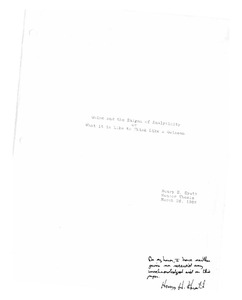| dc.rights.license | In Copyright | en_US |
| dc.creator | Hyatt, Henry H. | |
| dc.date.accessioned | 2023-10-20T18:01:05Z | |
| dc.date.available | 2023-10-20T18:01:05Z | |
| dc.date.created | 1988 | |
| dc.identifier | WLURG038_Hyatt_thesis_1988 | |
| dc.identifier.uri | https://dspace.wlu.edu/handle/11021/36483 | |
| dc.description.abstract | Quine's attack on what he considers to be two defunct dogmas of empiricism -- the notions of analyticity and reductionism -- is based on a misconception of the nature of language. Quine's fascination with the workings of scientific theory has led him to hold an overly-simple conception of language in which the purpose of all language is to report on the passing flux of experience. For Quine, language does not have any other function. In "Two Dogmas of Empiricism," Quine argues that the traditional concept of analyticity as necessary truth has no place in language. Quine contends that the only non-circular and intelligible definition of analyticity is the empiricist definition. According to this explanation, analytic truths are those statements which are confirmed by any possible experience. In order to show that no statement satisfies the empiricist criterion, Quine presents his network theory of belief. Quine
concludes that there are no necessary truths, statements that are true come what may. There are truths that are only more or less resistant to revision. I contend that there is an analytic/synthetic distinction to be drawn, but this distinction is not the classic "depends on language/depends on fact" distinction. To say that a statement is analytic is not to say
something about the relationship between the statement and experience, but to say that the statement has a certain role in our language. In this paper, I will first examine the traditional empiricist concept of analyticity. I then will explicate Quine' s view of a "more pragmatic" empiricism and will attempt to show that Quine's pragmatism leads to unacceptable results. Although I am not attempting to bring down the edifice of Quine's philosophy, I hope that my exposition will at least point out a few weak points in the Quinean fortress. [From introductory section] | en_US |
| dc.format.extent | 29 pages | en_US |
| dc.language.iso | en_US | en_US |
| dc.rights | This material is made available for use in research, teaching, and private study, pursuant to U.S. Copyright law. The user assumes full responsibility for any use of the materials, including but not limited to, infringement of copyright and publication rights of reproduced materials. Any materials used should be fully credited with the source. | en_US |
| dc.rights.uri | http://rightsstatements.org/vocab/InC/1.0/ | en_US |
| dc.title | Quine and the Enigma of Analyticity, or, What it is Like to Think Like a Quinean | en_US |
| dc.type | Text | en_US |
| dcterms.isPartOf | WLURG038 - Student Papers | en_US |
| dc.rights.holder | Hyatt, Henry H. | en_US |
| dc.subject.fast | Quine, W. V. (Willard Van Orman) | en_US |
| dc.subject.fast | Analysis (Philosophy) | en_US |
| dc.subject.fast | Language and languages | en_US |
